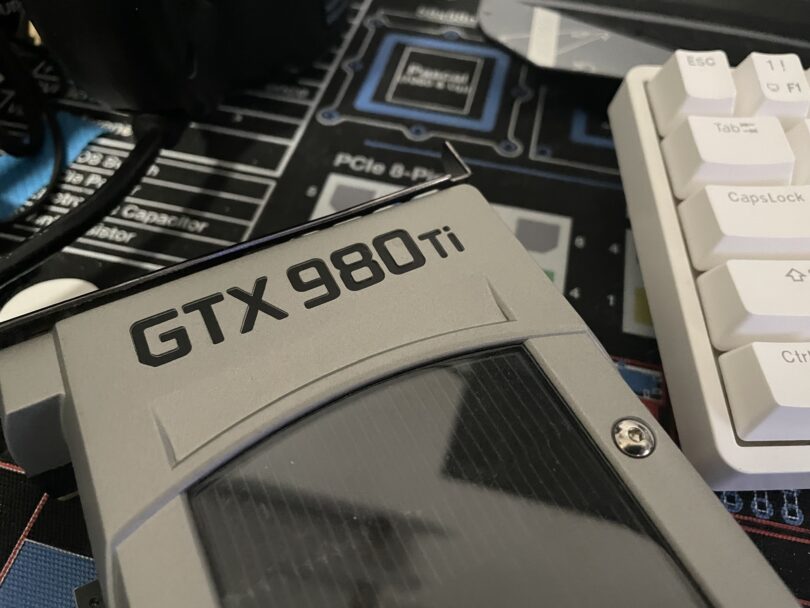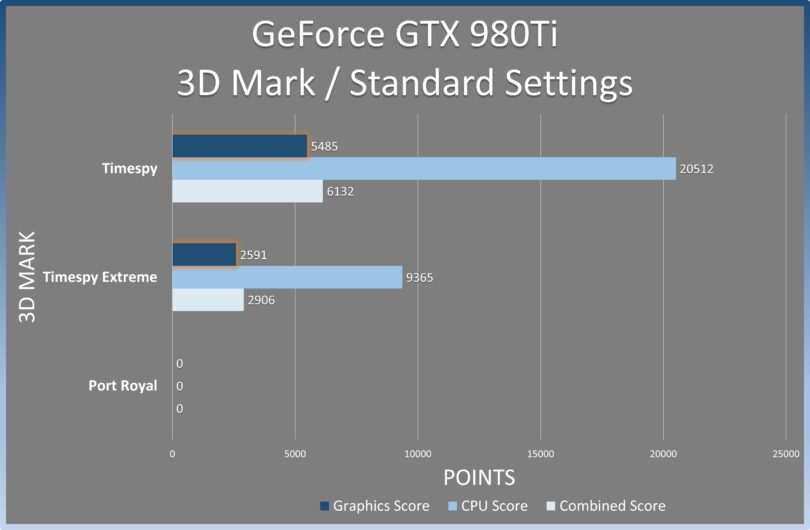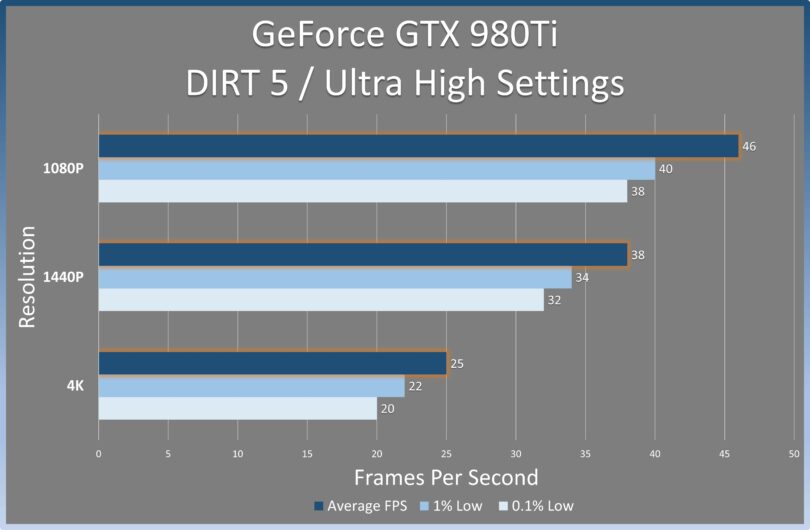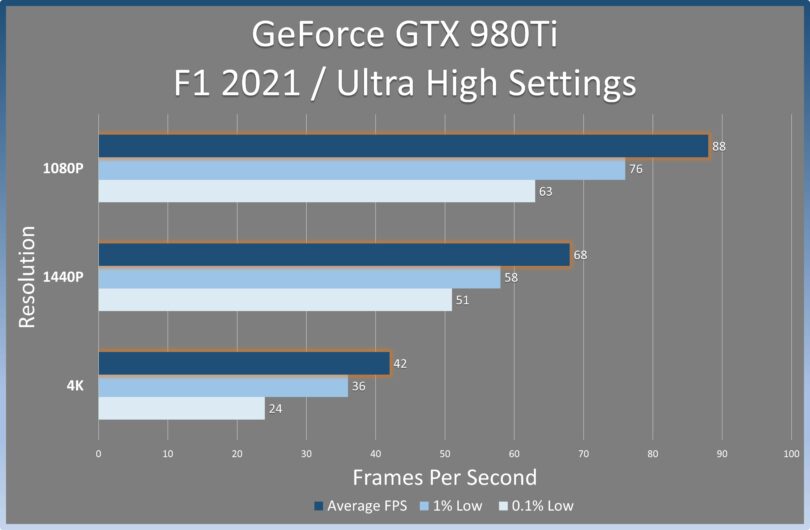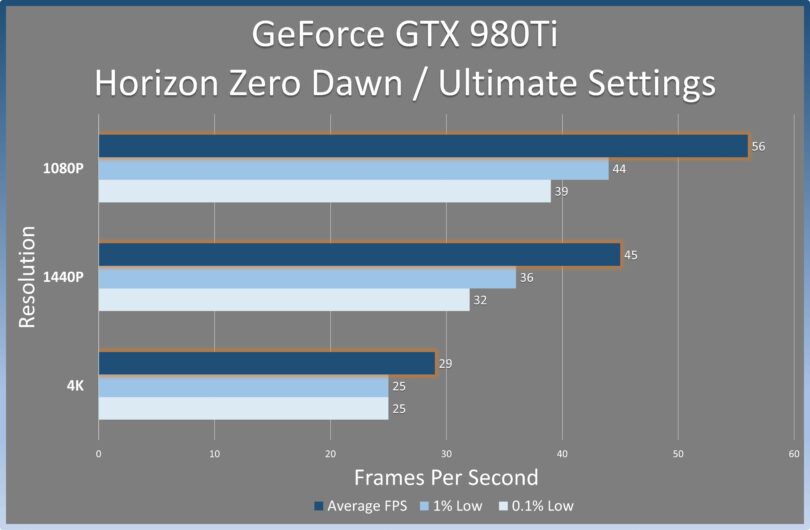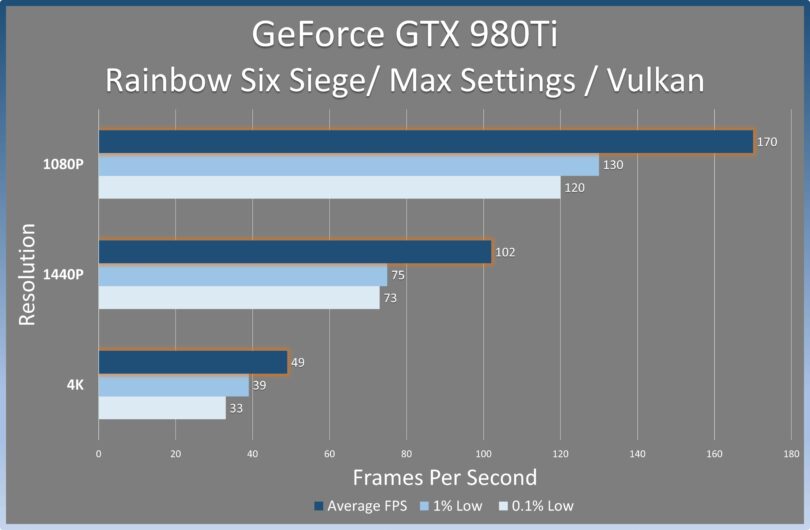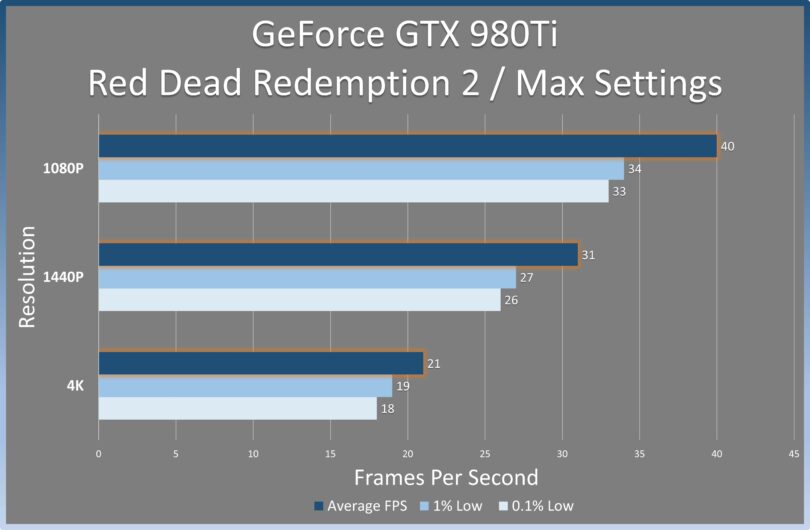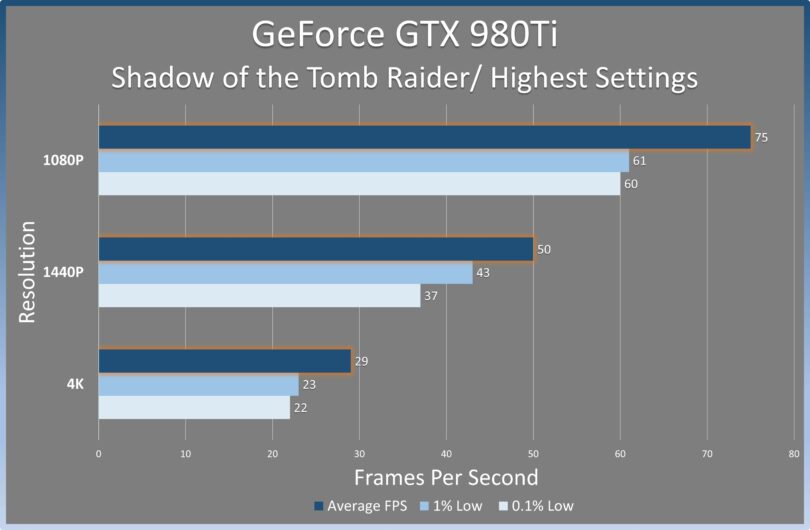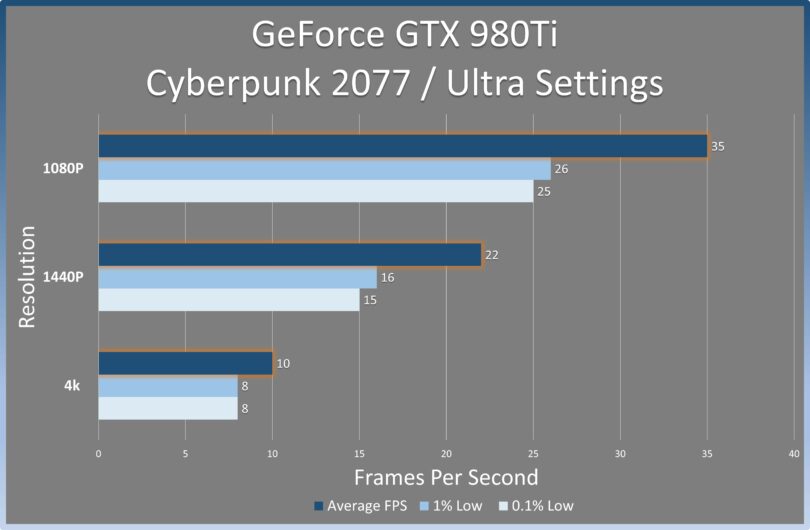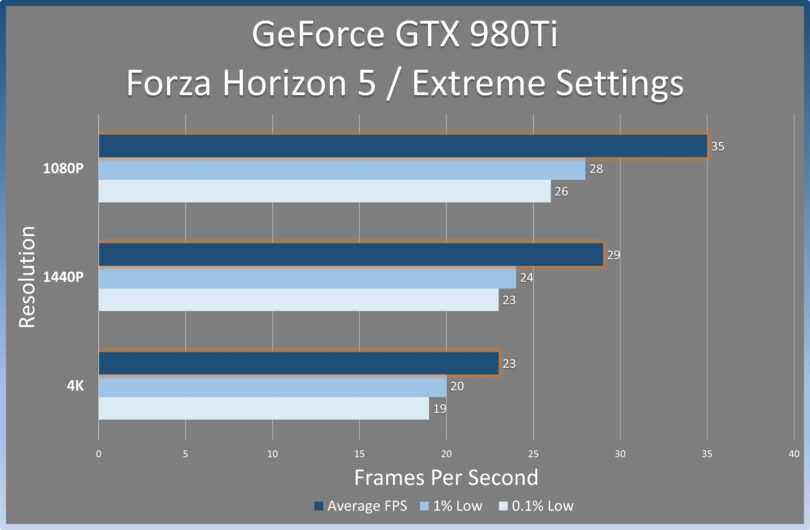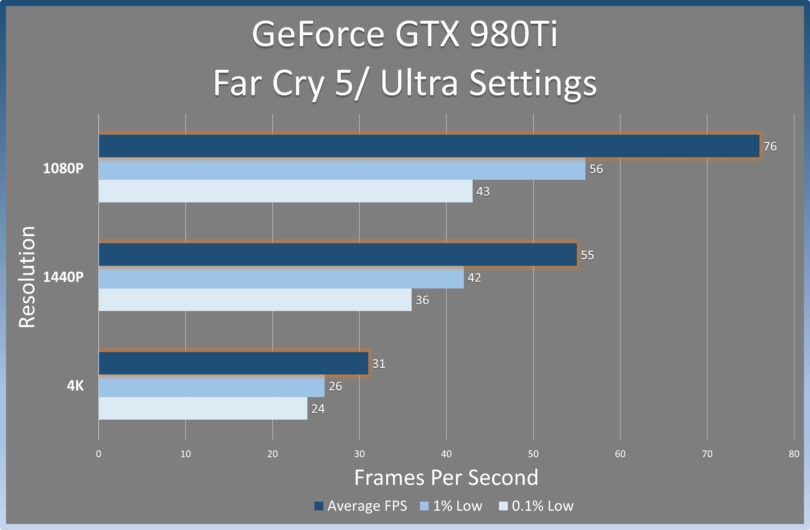In my experience, the GTX 980Ti is one of the best video cards ever produced. It was launched in the middle of 2015 at a now reasonable $649, and was nearly as fast as the Titan X of the time. It packed 6GB of VRAM which gave it lasting performance far longer than the 4GB GTX 980. It packed enough performance that it gave the next-generation 70 and 80 series Nvidia cards a run for their money. Quite frankly, there wasn’t a reason a to upgrade it unless you went for the GTX 1080Ti.
However, at 7 years since its launch, the GTX 980Ti is very old. Driver support is waning at best. Developers aren’t optimizing for the Maxwell architecture anymore. This leads to the question: Can the GTX 980Ti still game, or is it just too old now? Let’s find out.
Testing Methodology
Let me start by saying that this GPU was originally purchased by me in 2015, and lived a great gaming life in my NCASE M1 with a 6700K. It was so good that I skipped the 1000 series entirely, and went straight to the RTX 2080. Once I upgraded my main system, this GTX 980Ti then moved on from system to system never going out of service. After 7 years, I’ve finally run out of PCs to drop it into. Before it’s retired, I wanted to add it to our growing GPU performance charts.
Prior to benchmarking I performed a full cleaning and repaste with Thermal Grizzly Kryonaut. This actually didn’t make a difference in performance as the stock thermal paste was still functioning well.
This is a reference model blower-style 2-slot cooler. As a SFF enthusiast, I am a fan of these now classic coolers. They’re good looking, reasonably quiet, and exhaust heat out of the case. Performance wise however, they are pretty handily beaten by multi-fan axial coolers, if there is good airflow. If you want to overclock, and you have the opportunity to get a third party cooler model with a larger heatsink, I suggest doing so. Stock performance leveled out between 1,200 and 1,300 MHz, which is still far higher than the 1GHZ the chip was rated for. If you crank the fan up to ridiculously loud levels, this GTX 980Ti will get to almost 1,500mhz. Figure an extra 5 to 10 percent per game.
With that out of the way, let’s talk about testing methodology.
All GPU tests are conducted on an open bench or open frame case such as the Xtia XPROTO to provide the card’s maximum cooling potential. Obviously, whatever case you choose will have an effect on temps. A preliminary run of each benchmark is done to ensure functionality, and allow shaders to compile. This is done after every resolution change. Benchmarks are run three times, averaged, and measured using OCAT. As this is a test of graphical power, the highest graphical preset for each game is used for benchmarking. The benchmarking process is manually reviewed and monitored to ensure no errant behavior.
Test Configuration
- CPU: Intel 12900K at stock settings.
- Motherboard: MSI MEG Z690I Unify
- RAM: GSKILL DDR5-6400 CAS 32
- SSD: WD SN850
- 1,000 Watt EVGA PSU
- 360mm MSI AIO
- XTIA XPROTO XL Open Case
Test Game Engines and Games
- ForzaTech – Forza Horizon 5
- Unreal 4.0 – Gears of War 5 / Borderlands 3 (DX12) (Not included in this test)
- Ego – F1 2021
- REDengine 4 – Cyberpunk 2077
- Dirt5/Onrush Engine – Dirt 5
- Dunia Engine – Far Cry 5
- Foundation Engine – Shadow of the Tomb Raider
- Rockstar Advanced Game Engine – Red Dead Redemption 2
- AnvilNext 2.0 Engine – Rainbow Six Siege (Vulkan)
- Decima Engine – Horizon Zero Dawn
NOTE: Due to a chart error Gears of War 5 and Borderlands 3 will be added at a later date.
Benchmarks
One caveat to keep in mind is that this is a benchmark, and not an optimization guide. It is absolutely true you can lower settings and engage technology like FSR 2.0 in many of these games. Doing so, you will see a substantial improvement in performance. Moreover, Ultra/Max settings are often an egregious use of GPU resources on visual differences that most people don’t even notice. However, that’s information for a different article. In this case, we’re looking at if the GTX 980Ti can still run everything maxed at out at our most common resolutions, and provide a playable experience. More specifically, can the GTX 980Ti still provide an Ultra Settings Experience at any resolution?
3DMARK
Our look at the GTX 980Ti starts with the venerable 3DMark by UL Solutions. This is a synthetic test that has proven to be a useful tool in comparing raw output of GPUs.
At 5,485 points for the graphics score, the 980Ti is pretty far off from the near 18,000 that a RTX 3080 will put up. However, it’s not terrible when looking at 1080P resolutions.
Timespy Extreme, which is a 4K test, showed a score of 2,591 points for the GTX 980Ti. This is a far cry from the 9,000 point scores a GTX 3080 will produce indicating that 4K gaming is going to be limited to older games, lower setting, or both.
Port Royal is a Ray Tracing benchmark that the GTX 980Ti does not support.
Dirt 5
Dirt 5 uses a customized version of the Onrush engine, and is available on both current and last gen consoles.
The GTX 980Ti takes a beating in Dirt 5. 1080P gaming at an almost locked 40FPS is certainly possible if your display supports it. At 1440P, a locked 30FPS is achievable. However, moving to 4K is beyond the reach of the GTX 980Ti, and the card simply can’t reach 60FPS at any tested resolution without substantially cutting settings down. For reference, the GTX 1080 we recently tested averaged 41% faster performance at 1080P in this game.
F1 2021
F1 2021 runs on the EGO engine, and is far more gentle on GPUs then Dirt 5.
At 1080P, the GTX 980Ti claws its way to a locked 60FPS experience with room to spare. 1440P still plays well at a nearly locked 60FPS, but 4K shows some larger stutters as shown in the 24FPS 0.1% Lows. If you can tolerate them, the GTX 980Ti could still play the game decently at about 30FPS at 4K as the 1% lows are still above 30.
Horizon Zero Dawn
Horizon Zero Dawn uses the Decima engine, and was originally designed for the Playstation 4 base model. The settings tested here are higher quality than the settings used in the PS4 version.
At 1080P, the GTX 980Ti could achieve an almost locked 40 FPS experience. Switching to a VRR monitor provides average performance near 60FPS. 1440P is good for a locked 30FPS, but 4K falls well below that with stutters down into the 25FPS range.
Rainbow Six Siege
Rainbow Six Siege runs on the Anvil Next 2.0 Engine, which is not demanding for modern hardware. Additionally, it also uses the Vulkan API as opposed to Direct X. As this game was released after the GTX 980Ti came to market, it’s an interesting look at what performance was available back in 2015.
While the average FPS results look good, all of the tested resolutions show large deviations from their average frame in the 1% and 0.1% lows. This would be experienced as stutters or sudden drops of perceived smoothness even in a VRR display. However, at 1080P, the GTX 980Ti can still provide a locked 120FPS experience with averages going far above that. At 1440P the game is easily locked at 60FPS, but with a VRR display can be anywhere between 73 and 102 FPS.
4K gaming is a console-like locked 30FPS with VRR allowing for frame rates that average 49. That would be a competitive disadvantage so I don’t recommend it for multiplayer.
Red Dead Redemption 2
Red Dead Redemption 2 comes riding in on Rockstar Advanced Game Engine, and can push even modern GPUs hard.
The only resolution that the GTX 980Ti could provide a locked experience is at 1080P, and at only 30FPS. Everything else was just out of reach for this venerable GPU.
Shadow of the Tomb Raider
Shadow of the Tomb Raider uses the Foundation Engine, and was tested using DX12.
Considering the fidelity of the graphics in Shadow of the Tomb Raider it’s a pleasant surprise to see the GTX 980Ti pushing a locked 60FPS experience at 1080P. At 1440P resolution, the GTX 980Ti could easily provide a locked 30FPS and a nearly locked 40FPS experience. A VRR monitor will allows that to boost all the way to 50FPS. 4K could not reach even an average of 30FPS.
Cyberpunk 2077
Cyberpunk 2077 is perhaps the most demanding game in the last few years, and runs on the RED engine. It can bring even the highest end GPUs to their knees. Can the GTX 980Ti run Cyberpunk?
The answer is “No”; at least not at Ultra settings.
The GTX 980Ti has met its match Cyberpunk 2077. None of our tested resolutions could maintain a locked 30FPS. To be fair, this game also crushed the GTX 1080 which was 23% faster on average at 1080P. This is the problem with older GPUs; companies do not optimize for them. Nvidia did not put the amount of effort into their drivers for the GTX 980Ti that they did their newer cards, and CD Red did not build the game around the old Maxwell architecture.
Still, it’s impressive that it took this caliber of a game to bring down the GTX 980Ti.
Forza Horizon 5
Forza Horizon 5 runs on the ForzaTech engine, which scales to everything from the highest end PCs to last generation consoles. How does the GTX 980Ti handle it at Ultra settings?
Another strike out.
The GTX 980Ti fared better in Forza than Cyberpunk, but it still couldn’t maintain a locked 30FPS in any of our tested resolutions. I don’t blame the silicon though. This game has clearly not been optimized for older Maxwell architectures as the newer Pascal based GTX 1080 was 60% faster on average at 1080P.
Far Cry 5
Far Cry 5 on the Dunia Engine and is more forgiving to older architectures. We do plan to replace this benchmark with Far Cry 6 when the game has had a little more time to mature.
The GTX 980Ti at first appears to put up a solid fight at 76FPS average at 1080P. However, looking at the 1% and 0.1% lows, there are massive drops in performance that would be very noticeable. You’re going to be able to tell when your game suddenly drops its frame rate by 43% even with VRR. Still, the GTX 980Ti is playable if far from a locked frame rate. At 1440P, the GTX 980Ti wasn’t much better, and 4K couldn’t even lock to 30FPS.
For reference, the GTX 1080 was able to pull 119FPS average at 1080P with a 0.1% low of 91.
Conclusion
I have a lot of fondness for the GTX 980Ti, and gamed on this one for many years. However, after 7 years, it’s time for the GTX 980Ti to retire. The GTX 980Ti simply can’t provide the Ultra Settings Experience that it once did. The 6GB of VRAM is looking small when even consoles are packing 16GB of memory, and the lack of driver and game optimizations are killing its performance. It’s only going to get worse from this point forward. It was a good run, but it’s over.
That said, it’s still quite a viable card for 1080P gaming at medium settings at least for the short term. Older games and e-sports titles will run well. Games designed to run on the last generation consoles (PS4 / XBOX One) should perform well. It certainly could be a viable card for a secondary or tertiary system. During the GPU shortage, it was a far better option than iGPUs. However, the current value just isn’t there if you have to go out and buy it.
A cursory look at eBay sees GTX 980Tis selling for $150 to $200 at the time of writing. For $25 more you can get a GTX 1080 or even a GTX 1080Ti. Even the AMD 5700XT is viable alternative. All will offer a better experience than the GTX 980Ti.
Moreover, this isn’t a great card for SFF computers either. Regardless of the blower cooler, it can pull over 250 watts of power. That’s a lot of heat in a small space, and far more power than the GTX 1080. In an NCASE M1 the GTX 980Ti put out enough heat to make the bottom of the case too hot to touch. Adding intake fans didn’t help much. In a sandwich style case like the Dan Case A4 SFX the GTX 980Ti will radiate that heat right up against the rear NVME drive on the back of your ITX motherboard. It’s not a good situation.
As a fan of this card, it’s with a heavy heart that I have to say that I simply can’t recommend the GTX 980Ti anymore. It had an amazing run. Far longer than even the legendary Voodoo2 from 3DFX, but its time has come.

